I'm having difficulties plotting my bar chart after I pivot my data as it can't seem to detect the column that I'm using for the x-axis.
This is the original data:
import pandas as pd
data = {'year': [2014, 2014, 2014, 2015, 2015, 2015, 2016, 2016, 2016, 2017, 2017, 2017, 2018, 2018, 2018, 2019, 2019, 2019, 2020, 2020, 2020, 2021, 2021, 2021],
'sector': ['Public Sector', 'Private Sector', 'Not in Active Practice', 'Public Sector', 'Private Sector', 'Not in Active Practice', 'Public Sector', 'Private Sector',
'Not in Active Practice', 'Public Sector', 'Private Sector', 'Not in Active Practice', 'Public Sector', 'Private Sector', 'Not in Active Practice',
'Public Sector', 'Private Sector', 'Not in Active Practice', 'Public Sector', 'Private Sector', 'Not in Active Practice', 'Public Sector', 'Private Sector', 'Not in Active Practice'],
'count': [861, 531, 2, 877, 606, 66, 899, 682, 112, 882, 765, 167, 960, 804, 203, 943, 834, 243, 1016, 876, 237, 1085, 960, 215]}
df = pd.DataFrame(data)
year sector count
0 2014 Public Sector 861
1 2014 Private Sector 531
2 2014 Not in Active Practice 2
3 2015 Public Sector 877
4 2015 Private Sector 606
5 2015 Not in Active Practice 66
6 2016 Public Sector 899
7 2016 Private Sector 682
8 2016 Not in Active Practice 112
9 2017 Public Sector 882
10 2017 Private Sector 765
11 2017 Not in Active Practice 167
12 2018 Public Sector 960
13 2018 Private Sector 804
14 2018 Not in Active Practice 203
15 2019 Public Sector 943
16 2019 Private Sector 834
17 2019 Not in Active Practice 243
18 2020 Public Sector 1016
19 2020 Private Sector 876
20 2020 Not in Active Practice 237
21 2021 Public Sector 1085
22 2021 Private Sector 960
23 2021 Not in Active Practice 215
After pivoting the data:
sector Not in Active Practice Private Sector Public Sector
year
2014 2 531 861
2015 66 606 877
2016 112 682 899
2017 167 765 882
2018 203 804 960
2019 243 834 943
2020 237 876 1016
2021 215 960 1085
After tweaking the data to get the columns I want:
sector Private Sector Public Sector Total in Practice
year
2014 531 861 1392
2015 606 877 1483
2016 682 899 1581
2017 765 882 1647
2018 804 960 1764
2019 834 943 1777
2020 876 1016 1892
2021 960 1085 2045
As you can see, after I have pivoted the data, there is an extra row on top of the year called 'sector'.
sns.barplot(data=df3, x='year', y="Total in Practice")
This is the code that I'm using to plot the graph but python returns with:
<Could not interpret input 'year'>
I've tried using 'sector' instead of 'year' but it returns with the same error.


